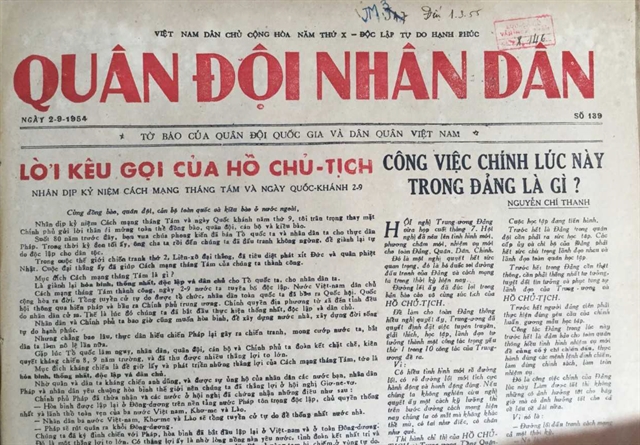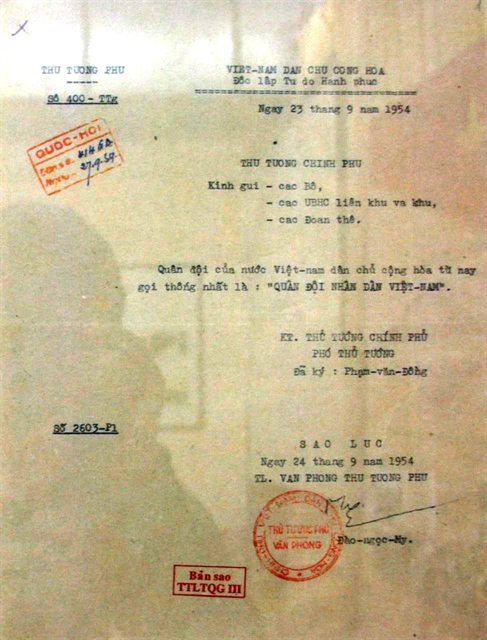 Politics & Law
Politics & Law

 |
by Lady Borton
There is delight in being wrong.
A writer's tasks should include checking details.
For me, that process involves Vietnamese colleagues, who will correct me before a text goes to print. Such was the case for a manuscript, Việt Nam's People's War: Điện Biên Phủ and Beyond.
A friend pointed out that my using "National Army" for the People's Army of Việt Nam (PAVN) during the years leading up to Điện Biên Phủ caused confusion with the army in former South Việt Nam. Further, she referred me to Vietnamese articles on the Web saying that, by 1950, "People's Army" was already in use.
I began to check.
It turns out we were wrong.
First, I searched the source for Vietnamese articles citing the 1950 date. The results are fuzzy. On December 19, 1950, according to the ten-volume chronology of Hồ Chí Minh's life, President Hồ wrote a letter, from which the Chronology quotes only a fragment. The Chronology, which is usually rigorous about references, cites no source for the quotation — "Our army is the people's army because the people gave birth to the army…."
A colleague at the Hồ Chí Minh Museum pointed out that this quotation is an observation, not a sắc lệnh (decree). A change in the army's name would have required a decree. I had overlooked a detail she noticed for the same day, December 19,1950. President Hồ presented the Hồ Chí Minh Award, Third Rank to General Võ Nguyên Giáp, "commander of the Việt Nam National Army and Militia."
Here was my mistake: I had overlooked the army's full name, specifically "Militia"!
But the tag used by Hồ Chí Minh for the award meant "People's Army of Việt Nam" became official usage after 1950.
I then checked the successive volumes of the Chronology and President Hồ's Collected Works. I found no decree about the army and no use of a full name for the army until September 2, 1954, when President Hồ presented the Military Award, First Rank, to General Giáp as "commander of People's Army of Việt Nam."
This meant "People's Army of Việt Nam" must have become official usage between 1950 and 1954.
A Vietnamese historian now in his nineties had been among the editors for the Collected Works. I had not asked him about decrees (We were talking about something else), but he mentioned that he had read them all. So, of course, I asked. His memory is clear. He could not remember seeing a decree about naming the army. He thought the change might have occurred with the first publication of Quân Đội Nhân Dân (People's Army newspaper).
 |
That led me to the National Library and the newspaper's first edition on October 20, 1952. This was a treat, not part of my plan for the day — to see the original paper with careful print on rough paper and half of the front page given over to a huge, complex drawing cum cartoon. There, under the folio was the tag: "Newspaper of the National Army and Militia of Việt Nam." The bound volume for the newspaper spanned until the end of 1954. To my surprise, that same tag appeared on all successive issues through August 22, 1954, the anniversary edition for Việt Nam's largely peaceful August 1945 Revolution.
There! The final paragraph in General Nguyễn Chí Thanh's lead article, "The Role of the People's Army in the New Situation," announced, "President Hồ and the Party Central Level have promulgated three new missions. The first is consolidating and organising defence forces. In correctly implementing the directives from President Hồ and the Party Central Level, we are determined to consolidate and exert our strength to organise our forces so that the People's Army has a strong effect and makes an important contribution to the new situation in our new, current struggle."
Here, we have a public announcement with the new name in the headline and text.
To be accurate, in the Vietnamese text, following Vietnamese editorial style, the newspaper capitalised "People's" but not "army." Thus, the name was formal. Publication in the article's headline and text announced the decision, but that was August 22, 1954. The tag under the newspaper's folio still retained the army's old name.
On September 2, 1954, the edition honouring Việt Nam's National Day, the tag under the folio changed to "Newspaper of the People's Army of Việt Nam."
But the mystery remained. When did the decision occur?
That question took me back to Hồ Chí Minh's Collected Works, to the Collected Party Documents, and eventually to the Party Central Committee Meeting, July 15-17, 1954, before the signing of the Geneva Agreements. In his report, President Hồ defined the need to "expand the forces of the people's army (not capitalized) and establish a strong people's army (again, not capitalized) appropriate to the demands of the new situation."
The formal decision from the meeting contains the same wording, also without a formal name, since "people's" remained in lower case.
So, yes, here was decision that Quân Đội Nhân Dân formalized on August 22 and September 2, 1954, when commemorating two of Việt Nam most important anniversaries.
But the mystery remained. Surely, a piece remained missing.
Another Vietnamese colleague, a superb researcher, found the official announcement. On September 29, 1954, the office of Prime Minister Phạm Văn Đồng sent to all ministries and high-level offices Official Dispatch No. 400 – TTg, which included this statement: "The army of the Democratic Republic of Việt Nam [DRVN] shall hereafter be uniformly called the People's Army of Việt Nam."
There!
Vietnamese friends and colleagues have unravelled the mystery.
To avoid being too arcane by choosing between July 15-17, 1954, or August 22, or September 2, or September 29, we might simply say the DRVN implemented the formal name of today's army in September 1954.
But not in 1950. — VNS




